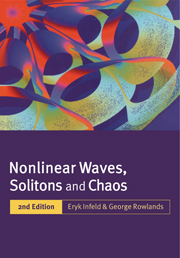Book contents
- Frontmatter
- Contents
- Foreword to the first edition
- Foreword to the second edition
- 1 Introduction
- 2 Linear waves and instabilities in infinite media
- 3 Convective and non-convective instabilities; group velocity in unstable media
- 4 A first look at surface waves and instabilities
- 5 Model equations for small amplitude waves and solitons; weakly nonlinear theory
- 6 Exact methods for fully nonlinear waves and solitons
- 7 Cartesian solitons in one and two space dimensions
- 8 Evolution and stability of initially one-dimensional waves and solitons
- 9 Cylindrical and spherical solitons in plasmas and other media
- 10 Soliton metamorphosis
- 11 Non-coherent phenomena
- Appendices
- References
- Author index
- Subject index
- Plate section
9 - Cylindrical and spherical solitons in plasmas and other media
Published online by Cambridge University Press: 05 June 2012
- Frontmatter
- Contents
- Foreword to the first edition
- Foreword to the second edition
- 1 Introduction
- 2 Linear waves and instabilities in infinite media
- 3 Convective and non-convective instabilities; group velocity in unstable media
- 4 A first look at surface waves and instabilities
- 5 Model equations for small amplitude waves and solitons; weakly nonlinear theory
- 6 Exact methods for fully nonlinear waves and solitons
- 7 Cartesian solitons in one and two space dimensions
- 8 Evolution and stability of initially one-dimensional waves and solitons
- 9 Cylindrical and spherical solitons in plasmas and other media
- 10 Soliton metamorphosis
- 11 Non-coherent phenomena
- Appendices
- References
- Author index
- Subject index
- Plate section
Summary
Interest in higher dimensional plasma solitons
As we have seen, quite a lot is now known about one-dimensional plasma waves and solitons. Possibly as a continuation of this effort, or again possibly as a result of most scientists' impatience with a field once it has disclosed some of its secrets, a new discipline of cylindrical and spherical plasma soliton waves has come into being. Investigations began fairly recently (Maxon and Viecelli (1974a,b)), but progress is rapid. Similar phenomena in other fields of classical physics are mentioned briefly at the end in Section 9.7.
In mathematical terms, the cylindrical and spherical plasma (and hydrodynamic) solitons treated here are often described quite well by variants of the model equations that have already appeared in this book. Examples are the Korteweg–de Vries (KdV) cum Boussinesq family (ion acoustic solitons), and the nonlinear Schrödinger family in various geometries and with diverse nonlinearities, the simplest being a cubic term (Langmuir envelope solitons). Both are of course classes of idealized equations. Here we will see how they can be obtained in the higher dimensional, non-Cartesian plasma physics context, what their properties are and also some of the effects they do not describe. Finally, we will see how some of their predictions stand up to laboratory and numerical experiments. A few extensions of the above models will we suggested.
Comparatively little theoretical work has been done on the stability of higher dimensional solitons, existing analyses being either very restricted or incomplete.
- Type
- Chapter
- Information
- Nonlinear Waves, Solitons and Chaos , pp. 268 - 295Publisher: Cambridge University PressPrint publication year: 2000



